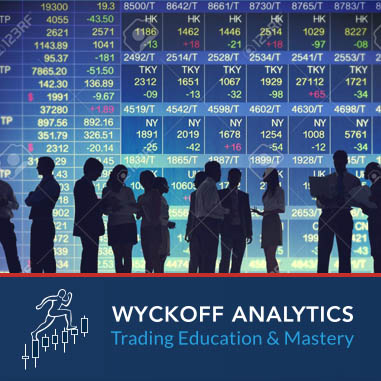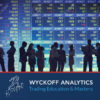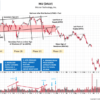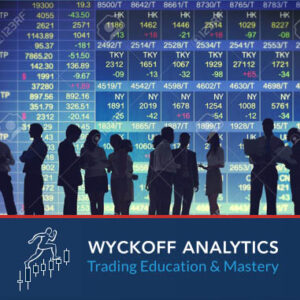Wyckoff Analytics – Wyckoff Trading Course (WTC)
Spring Series
Roman Bogomazov is a Wyckoff Method trader and educator. He is an Adjunct Professor at Golden Gate University in San
Francisco, where, together with the late Hank Pruden, he developed a Wyckoff Method online curriculum. He is also President of Wyckoff Associates, LLC, an enterprise providing online Wyckoff Method education to traders throughout the
world.
Sales page: http://www.wyckoffanalytics.com/wyckoff-trading-course-summer-series
COURSE CONTENT
WTC Part I (Spring 2019) – WYCKOFF STRUCTURAL PRICE ANALYSIS
Description: In the first four sessions of the WTC, you will learn how to to read market structure by applying Wyckoff’s
cardinal insights regarding the interplay of price, volume and time. Understanding market structure allows you to anticipate coming price action. You will learn to identify and analyze accumulation, distribution, re-accumulation and re-distribution – the key trading ranges that power trends. You will also learn Wyckoff Method trade set-ups based on market
structure, how to enter a new or an existing trend, and how to recognize in advance when a trend is likely to end.
1.The Price Cycle: Accumulation, Mark-Up, Distribution and Mark-Down
2.Change of Character in an established trend: identifying a change from a trending to a non-trending environment
3.Change of Character in a trading range: identifying price and volume action signaling the initiation or continuation of a
trend
4.Trading ranges that generate big trends: accumulation and distribution
5.A key concept in Wyckoff Method analysis of trading ranges: Phases
6.Phase anatomy: Wyckoff Method events (e.g., climaxes, tests, springs, upthrusts, signs of strength)
7.Identifying phases in accumulation and distribution
8.Characteristics of re-accumulation and re-distribution trading ranges
9.Distinguishing re-accumulation from distribution and re-distribution from accumulation
10.Three Wyckoff Method rules for trades based on market structure
11.Delineating Buying and Selling Zones using the Wyckoff Method, including entry and exit strategies
12.Exercises and homework assignments
Mini-course Duration: 4 online sessions
Dates: Monday afternoons; January 7, 14, 21 and 28
WTC Part II (Spring 2019) – SUPPLY AND DEMAND
Description: Here Mr. Bogomazov will focus in detail on identifying supply and demand on any chart. The Wyckoff Method is based on the assumption that all freely traded markets are governed by supply and demand. In today’s markets,
as in Wyckoff’s time, large professional interests dominate supply and demand. Having the ability to accurately read supply and demand on a chart will allow you to make better decisions about timing your entries and exits and to join the large operators rather than being caught on the wrong side of a trade.
1.Concepts in supply and demand – the forces that move all markets
2.Who is the composite operator and how do his actions in the market affect supply and demand?
3.Volume and spread analysis
4.Variations of spread and volume in different market environments
5.Effort (volume) versus results (price action) – confirmation and discordance both predict future price behavior
6.Volume analysis and schematics in trading ranges
7.Volume characteristics in different phases of accumulation and distribution
8.Wyckoff’s springboard: when price is poised to move
9.Tradable volume patterns
10.Exercises and homework assignments
Mini-course Duration: 4 online sessions
Dates: Monday afternoons; February 4, 11, 18, and 25
WTC Part III (Spring 2019) – RELATIVE AND COMPARATIVE STRENGTH
Description: Relative and comparative strength are Wyckoff Method concepts that can help you select the top stocks in
the best sectors to trade, particularly at market turns. In this part of the course, you will learn how to apply these concepts to identify candidates for long or short trades, and how they can also be used to improve the timing of your entries
and exits.
1.Relative and comparative strength analysis: how to choose the best vehicles to trade
2.Use of comparative strength for stock selection in the Wyckoff Method
3.Improving the Wyckoff Method’s comparative strength analysis in trading ranges
4.Differences between relative and comparative performance
5.Using changes in relative strength or weakness to spot sectors and stocks to trade
6.Creating selection filters using relative and comparative strength to identify high-probability trades
7.Exercises and homework assignments
Mini-course Duration: 4 online sessions
Dates: Monday afternoons; March 4, 11, 18, and 25
WTC Part IV (Spring 2019) – PUTTING IT ALL TOGETHER: DEVELOPING A WYCKOFF TRADING PLAN
Description: The previous sections of the WTC incorporate foundational elements of the Wyckoff Method and are designed to allow you to immediately apply standalone concepts to your own trading. For students who want to integrate these elements more deeply, Mr. Bogomazov teaches how to create a Wyckoff trading plan in the final three WTC sessions.
Because the content of this section relies so heavily on materials presented previously, participation will be limited to students who have attended WTC Parts I, II and III.
1.Using filters to improve selection of stocks or options to trade
2.Relative strength filters
3.Structural filters
4.Supply and demand filters
5.Using multiple filters to pinpoint the best trades and times to open positions
6.Market Analysis as a Filter – timing entries in sync with the market
7.Using Wyckoff Method concepts to create a trading plan
8.Back-testing your trading plan with a pre-formatted Excel template – key variables to track
9.Trading tactics for your Wyckoff trading plan: entries, position management, and exits
10.Exercises and homework assignments
Mini-course Duration: 3 online sessions
Dates: Monday afternoons; April 1, 8 and 15









